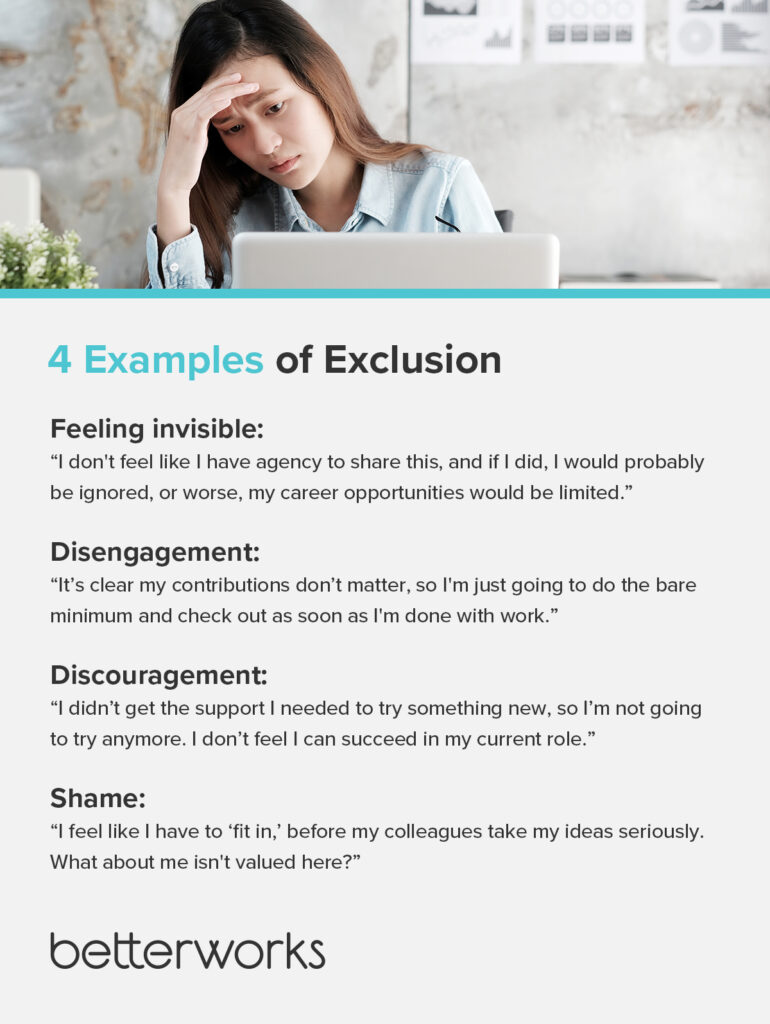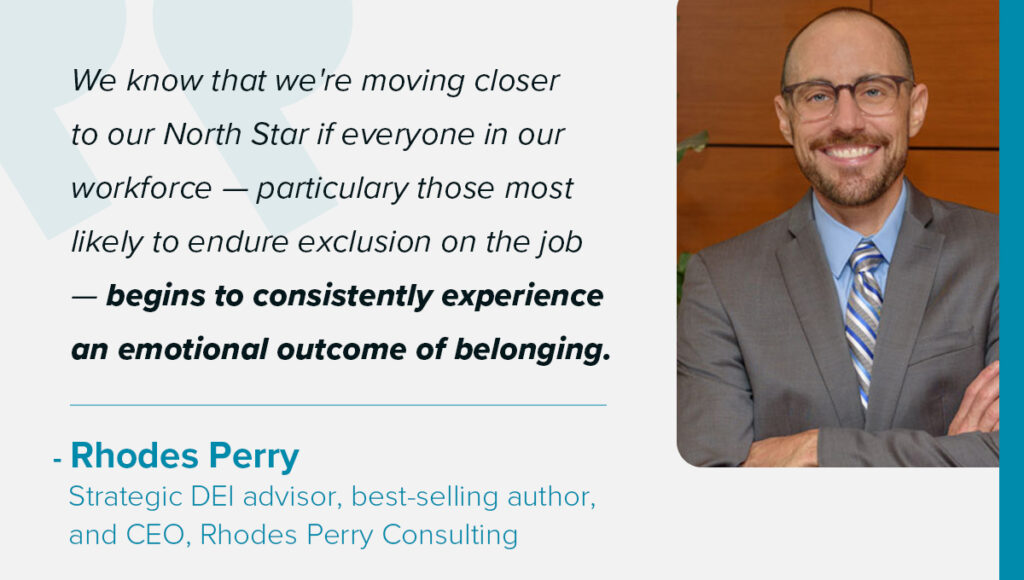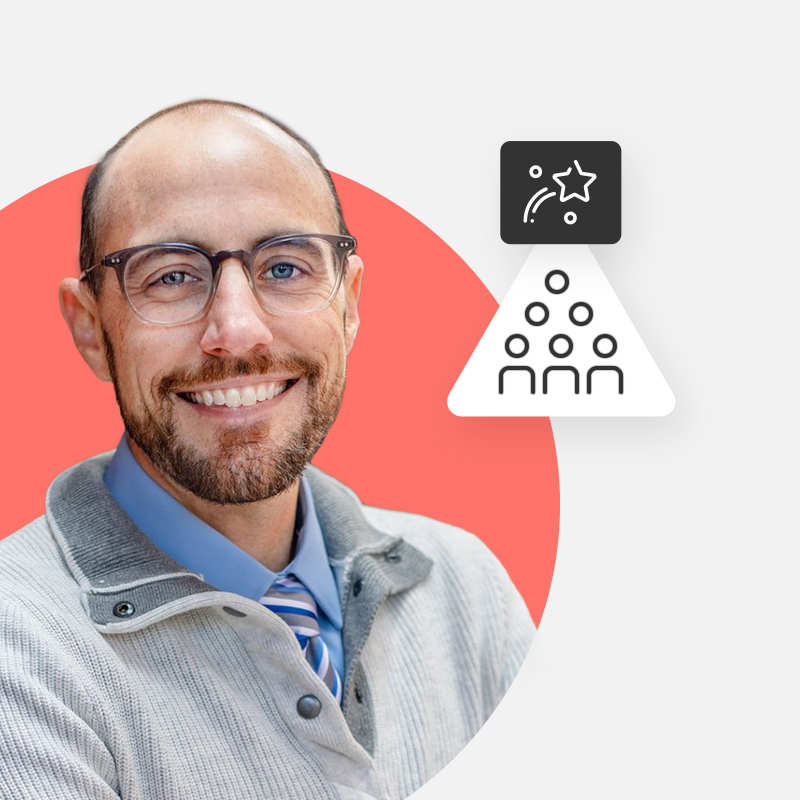Employers have historically struggled with measuring belonging because of its subjective nature. Additionally, those responsible for assessing workplace belonging often conflate the felt sense of belonging with the related concepts of diversity, equity, and inclusion (DEI) — further complicating how a workplace measures belonging at work.
Rhodes Perry, an experienced DEIB strategist, keynote speaker, and best-selling author of “Imagine Belonging” and “Belonging at Work,” wants to help every senior executive and people leader distinguish these differences.
“Diversity is a ‘people outcome’ measured by the representation of people from different cultures, identities, backgrounds, and lived experiences, while inclusion is a ‘behavioral outcome’ measured by how employees embody a company’s stated values,” Perry says. “Equity is a ‘systems outcome,’ measured by how well structures, policies, and practices give each person what they need so that they can succeed at work.”
So where does that leave belonging? “If we do all these things well — if we meet our people, behavioral, and systems goals — then we’re likely to experience an ‘emotional outcome’ of belonging, including employees and others who often experience moments of exclusion on the job,” he says.
To measure the emotional outcome of belonging at work, identify the groups of people most likely to experience moments of exclusion on the job, including things like overt acts of discrimination and, more commonly, microaggressions, or subtle acts of exclusion. You’ll often find these results by examining disaggregated demographic data from employee engagement surveys, and DEIB assessments.
We asked Perry to share his expertise, earned across a history of helping executives build psychological safety, trust, and belonging at work, to explain the building blocks of belonging and how to intervene when we witness subtle acts of exclusion.
Measure belonging across the workforce
Before an employee can enjoy a felt sense of belonging at work, they must first experience a sense of psychological safety on the job. To assess if an employee feels safe at work, ask them: Do you believe you can ask for help when you need it, admit to a mistake when you make one, and offer constructive feedback when you have it, without fear of negative consequences (i.e., job loss, being overlooked for a promotion, or missing out on a stretch assignment)?
If an employee responds “no,” to any of these psychological safety questions, the feeling of belonging will remain elusive. Negative responses are a signal to double down on efforts to build more safety and trust at work — the foundations for belonging. However, if they respond in the affirmative, then they may experience some, or all of what Perry coined, “The Belonging Ingredients,” or as Coqual reported in their 2019 Power of Belonging Report, the elements of belonging.
DEIB professionals and HR leaders can measure these belonging elements through culture assessments, employee engagement, and pulse surveys. They can ask questions such as, “On a scale of 1 to 5 (with 1 being least likely and 5 being most likely), how likely are you to experience the following ‘belonging ingredients’ at work?”
- I feel seen. I feel seen, valued, and appreciated for my skills, my expertise, my lived experiences, and for who I am (e.g., my culture, social identities, my background). My colleagues see me as a “value add” to my team, not as someone who simply “fits in.”
- I feel connected. I feel connected to my colleagues, my team, my leaders, and my organization because I have a strong sense of trust and rapport with those that I work with each and every day (i.e., teammates, peers across the company, and the organization itself).
- I am supported. I feel empowered to ask for what I need at work to succeed, and I’m willing to give what I can to support the success of my colleagues. I know that my colleagues have my back, and I’m ready to have theirs with the goal of our shared success.
- I feel pride: I feel proud that my personal values are in alignment with my organization’s stated values, and the values my team has created to help us make better decisions, share power, and take values-driven actions.
If your employees rate each of these independent “belonging ingredients” with a high score, then your organization will likely score high on belonging. You know you are building belonging at work when employees most likely to endure the sting of exclusion on the job rank these belonging ingredients with a high score. “We know that we’re moving closer to our North Star if everyone in our workforce — particularly those most likely to endure exclusion on the job — begins to consistently experience an emotional outcome of belonging,” Perry says.

Transform moments of exclusion into moments of belonging
It takes intentionality and commitment to sustain a belonging workplace culture, and short-term progress isn’t a guarantee that your belonging culture will remain if your employer has not made a long-term commitment. For example, if your company equipped your workforce with the skills to embody belonging behaviors three years ago, and there’s been a 40-50% turnover rate since then, subtle acts of exclusion could be back on the rise.
Without ongoing training and coaching on how to identify, repair, and prevent common subtle acts of exclusion from arising in your workplace, your workforce will struggle with an appropriate response to such behaviors in the moment. Left unchecked, microaggressions “erode safety and trust, the belonging building blocks,” Perry says, and may cause a tremendous amount of harm — particularly to employees most likely to endure moments of exclusion.
So what do you do when you witness a moment of exclusion? First, assess your own safety. “If you know that you can offer constructive feedback, request support when needed, or admit to a mistake when you make one, you most likely are psychologically safe,” Perry says. He goes on to caution that if you are psychologically safe, yet feel hesitation to upend a moment of exclusion, you most likely are experiencing discomfort. He urges leaders, “do not conflate your discomfort with feeling unsafe.”
If you are considering intervening, recognize that you most likely will feel some level of discomfort as you want to skillfully bring visibility to words, actions, or behaviors that have eroded a colleague’s sense of safety and trust. Understandably, you do not want to cause more harm, and you may be tempted to say nothing. Perry cautions again, “doing nothing in these moments of exclusion only endorses what is taking place. It’s important to take a ‘right risk,’ by serving as an upstander.”
If you do have psychological safety when bearing witness to a moment of exclusion, “silence is a statement, and it’s the worst statement to make in these moments when one of our colleagues has experienced harm,” Perry continues. To resist the tendency to remain silent, start by checking in on the person who’s been harmed. Empathize with them, and ask if they have any requests for how you should proceed. This check-in is the first action to learning more about the impact of another person’s actions and identifying possible bridges to repair the harm.
With consent from the person who was harmed, call in the person (or group) who caused the harm. This action will require taking that right risk to break the silence with an observation and question. For example, calling in a new employee who made an unskillful assumption and asking, “Tom, I noticed you assumed that Tony was the director. Can you share more about why you made that assumption?” From there, you can learn more about Tom’s intent, and offer more details about the impact it had on Amber, the director — providing she has consented to intervene — and that you are honoring a possible request that Tom consider this information and connect with her after the meeting to discuss.
Recognizing that each situation will have different factors at play, it’s good practice to always first check in with someone you are assuming experienced harm. Their feedback will offer helpful direction on what actions to take after these moments of exclusion, and your efforts will make a difference, even if it’s providing an empathetic ear to listen to a colleague processing the harm they’ve just experienced.

Supercharge innovation, creativity, and success
Belonging doesn’t just help employees feel better and gain more agency to show up as themselves at work: it also ignites their creativity and contributions, Perry says. Productivity and innovation are keys to success in today’s workplace, and leading brands recognize this truth. Yet, far too many company cultures resist new ideas or dissenting opinions. Developing an environment where innovation can thrive takes concrete actions, including fostering safety and trust — the belonging building blocks.
Consider these four examples of exclusion and how they might make you and your colleagues feel:
- Feeling invisible: “I don’t feel like I have agency to share this, and if I did, I would probably be ignored, or worse, my career opportunities would be limited.”
- Disengagement: “It’s clear my contributions don’t matter, so I’m just going to do the bare minimum and check out as soon as I’m done with work.”
- Discouragement: “I didn’t get the support I needed to try something new, so I’m not going to try anymore. I don’t feel I can succeed in my current role.”
- Shame: “I feel like I have to ‘fit in,’ before my colleagues take my ideas seriously. What about me isn’t valued here?”
While moments of exclusion undermine workplace creativity, belonging supercharges it. “When I think about exclusion, it causes me to constrain myself and to shrink, and I’m not in that generative or creative space,” Perry says. “Whereas if I consistently experience the ingredients of belonging, my mind, body, and spirit open up to imagining new possibilities, I start to smile, and I believe that realizing these new imaginations are within reach.”
Want to learn more? Discover how HR can lead the way on DEI outcomes.
How HR Can Lead the Way on DEI with Dr. Stephanie Creary


